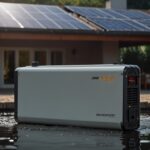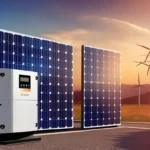Solar farms are becoming an increasingly popular way to generate renewable energy, with many benefits for the environment and local communities. However, to ensure that these installations are running at their maximum efficiency, it’s essential to have a solid plan in place for solar farm vegetation management. In this blog post, we’ll explore the importance of vegetation management and planning for solar farms, as well as some best practices for implementation.
Why is Solar Farm Vegetation Management Necessary?
Solar farms, by their very nature, rely on the uninterrupted exposure of solar panels to sunlight. Any obstruction to this exposure can significantly reduce energy production. Vegetation, in particular, poses a challenge as it can grow rapidly and obscure solar panels if left unchecked. To maximize energy generation and the lifespan of solar panels, effective vegetation management is essential before you build a solar farm. Here are some reasons why:
Energy Efficiency: Solar panels generate electricity when exposed to sunlight. When vegetation, such as tall grasses or shrubs, shades the panels, it reduces their efficiency. A well-managed solar farm ensures that panels receive the maximum amount of sunlight, leading to higher energy production.
Preventing Damage: Overgrown vegetation can damage solar panels. Branches, leaves, and debris can fall onto panels, potentially causing physical damage. Proper vegetation management minimizes these risks and extends the lifespan of the equipment.
Fire Prevention: Dry vegetation can become a fire hazard in areas prone to wildfires. Effective vegetation management reduces the risk of fires spreading through the solar farm.
Compliance: Many regions have regulations and permits related to solar farm operations, including vegetation management. Compliance with these regulations is crucial to avoid fines and operational disruptions.
Aesthetics: Solar farms are often located in visible areas. Proper vegetation management enhances the appearance of the site, which can be important for public relations and community acceptance.
Now that we understand why vegetation management is vital, let’s explore the key considerations for planning and implementing effective strategies.
Planning for Solar Farm Vegetation Management
Site Selection
The first step in vegetation management begins with site/ land selection for solar farm. Choosing a location with minimal vegetation growth, especially fast-growing species, can significantly reduce maintenance efforts. Conducting a thorough environmental assessment is crucial to understanding the local flora and fauna.
Native Planting
Where feasible, consider planting native vegetation around the solar panels. Native plants are adapted to the local climate and soil conditions, often requiring less water and maintenance. They can also provide habitat for local wildlife, promoting biodiversity.
Design and Layout
The layout of solar panels can influence vegetation management. Optimal spacing and panel tilt angles can minimize shading and create easier access for maintenance equipment.
Access Roads
Ensure that access roads for maintenance vehicles are well-planned and maintained. This will facilitate regular inspections and maintenance activities, reducing the risk of vegetation overgrowth.
Regular Inspections
Implement a routine inspection schedule to identify and address vegetation issues promptly. Regular inspections can prevent minor issues from escalating into major problems.
Monitoring Technology
Embrace technology such as drones and remote monitoring systems equipped with cameras and sensors. These tools can provide real-time data on vegetation growth, enabling timely intervention.
Integrated Pest Management
Use integrated pest management techniques to control weed growth. This approach combines biological, chemical, and mechanical methods to manage vegetation effectively while minimizing environmental impact.
Community Engagement
Engage with the local community to garner support for your vegetation management efforts. Explain the ecological benefits and long-term sustainability goals of your solar farm.
Implementing Solar Farm Vegetation Management Strategies Effectively
- Mowing and Trimming: Regular mowing and trimming are essential to keep grasses and shrubs in check. Ensure that the equipment used is designed for solar farm environments to prevent damage to panels.
- Herbicides: When necessary, use herbicides carefully and in compliance with local regulations. Choose environmentally friendly options whenever possible to minimize ecological impact.
- Manual Removal: In some cases, manual removal of invasive plants may be required. This labor-intensive process can be effective for smaller solar farms or areas with sensitive ecosystems.
- Grazing Animals: Consider using grazing animals like sheep or goats for vegetation control. They can help maintain grassy areas without the need for heavy machinery.
- Mulching: Applying mulch around the base of solar panels can inhibit weed growth and retain moisture in the soil.
- Erosion Control: Implement erosion control measures, such as the installation of silt fences and erosion blankets, to protect against soil erosion caused by vegetation removal.
- Firebreaks: In fire-prone areas, create firebreaks by clearing vegetation around the solar farm. This reduces the risk of wildfires spreading to the site.
Conclusion
Solar farm vegetation management and planning are integral parts of maintaining the efficiency and sustainability of solar energy installations. As the world continues to transition toward renewable energy sources, it is essential to consider not only the technology but also the natural environment in which these systems operate. By implementing effective vegetation management strategies and adhering to sustainable practices, solar farm operators can harness the power of nature while contributing to a more sustainable and greener future. Through careful planning and ongoing management, solar farms can shine as beacons of clean energy generation, all while coexisting harmoniously with the surrounding environment.

















